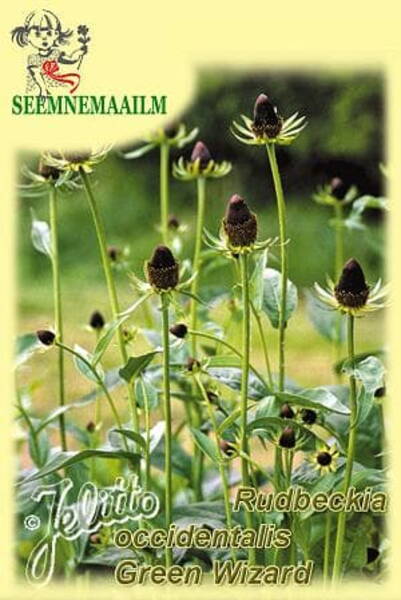Your shopping cart is empty!
Western coneflower "Green Wizard" (black beauty coneflower)
Rudbeckia occidentalis Nutt.
2.41€
Ex Tax: 1.95€
Ex Tax: 1.95€
Western coneflower "Green Wizard" - Rudbeckia occidentalis.
Perennial from the Asteraceae family.
It has a very original flower shape: a dark convex center is surrounded by green petals.
The inflorescence is devoid of reed flowers and looks like a black cone surrounded by green bracts.
Flowering plant height: 100-120 cm.
Natural flowering period: July - September.
It is photophilous, drought-resistant and quite frost-resistant, it is not demanding on soils.
Winter hardiness zones: Z5 - Z9.
Used for groups and mixborders. Can be very original in flower arrangements. Suitable for cutting. Good honey plant.
1,0 g = 420 seeds.
A very curious and extraordinary plant for the back of borders. Bright green sepals, where most plants have petals and a central, almost black cone. An unusual fresh-cut flower, long-lasting in water, or use in dried arrangements. Easy to grow, quickly forming a good-sized plant with plenty of lush green foliage and always a talking point.
Sowing Instructions.
Sow from late winter to mid-summer 6mm (¼in) deep in good seed compost. Make sure the compost is moist but not wet and seal it inside a polythene bag until after germination usually 5-21 days at 18-20 °C. The seed usually germinates within this time but if not, place in a fridge, and leave at +3+5°C for 2-3 weeks, then return to the warmth. Inspect regularly while in the fridge and remove them immediately after they start to germinate.
Growing Instructions.
Transplant seedlings when large enough to handle into 7.5 cm pots. Later plant out 30 cm apart in full sun and ordinary well drained garden soil.
Aftercare Instructions.
Cut stems down in late autumn.
Perennial from the Asteraceae family.
It has a very original flower shape: a dark convex center is surrounded by green petals.
The inflorescence is devoid of reed flowers and looks like a black cone surrounded by green bracts.
Flowering plant height: 100-120 cm.
Natural flowering period: July - September.
It is photophilous, drought-resistant and quite frost-resistant, it is not demanding on soils.
Winter hardiness zones: Z5 - Z9.
Used for groups and mixborders. Can be very original in flower arrangements. Suitable for cutting. Good honey plant.
1,0 g = 420 seeds.
A very curious and extraordinary plant for the back of borders. Bright green sepals, where most plants have petals and a central, almost black cone. An unusual fresh-cut flower, long-lasting in water, or use in dried arrangements. Easy to grow, quickly forming a good-sized plant with plenty of lush green foliage and always a talking point.
Sowing Instructions.
Sow from late winter to mid-summer 6mm (¼in) deep in good seed compost. Make sure the compost is moist but not wet and seal it inside a polythene bag until after germination usually 5-21 days at 18-20 °C. The seed usually germinates within this time but if not, place in a fridge, and leave at +3+5°C for 2-3 weeks, then return to the warmth. Inspect regularly while in the fridge and remove them immediately after they start to germinate.
Growing Instructions.
Transplant seedlings when large enough to handle into 7.5 cm pots. Later plant out 30 cm apart in full sun and ordinary well drained garden soil.
Aftercare Instructions.
Cut stems down in late autumn.












